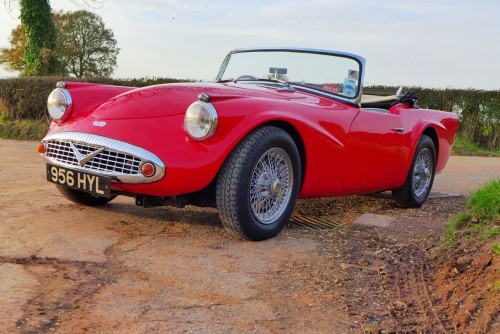
Click Here for Full Screen Image - Click Here to Download Image
 |  |  |  |  | |||||
 |  |  |  |  | |||||
 |  |  |  |  |
| Lot number | 49 |
|---|---|
| Hammer value | £27,000 |
| Description | Daimler Dart SP250 Manual |
| Registration | 956 HYL |
| Year | 1960 |
| Colour | Red |
| Engine size | 2,548 cc |
| Chassis No. | 100661 |
| Engine No. | 96290 |
One of the oldest and soberest names in motoring history, Daimler was long famed for producing a string of worthy but unremarkable cars aimed at satisfying the conservative tastes of the upper-middle-class motorist. How extraordinary, then, that they should spring one of the most outlandish sportscars ever to grace the highway onto an unsuspecting public.
Aimed squarely at the American market, the Daimler Dart was launched at the 1959 New York Motor Show but was soon renamed the SP250 after Chrysler asserted that they had already trademarked the Dart name for a forthcoming Dodge. It featured a truly wacky glassfibre body that combined a bewildering assortment of curves, bulges and fins with a face that came straight from a grouper fish. Love it or hate it, you certainly can’t ignore it.
Built on a traditional cruciform-braced ladder-frame chassis equipped with independent coil-and-wishbone front suspension and a leaf-sprung 'live' rear axle, it had modern disc brakes all round and a four-speed manual gearbox with synchromesh on the top three speeds.
But what really grabbed the attention of anyone who drove it was the magnificent V8 engine. Designed by Edward Turner, this 2.5-litre ‘hemi’ is one of the most charismatic engines ever made, a lightweight marvel of unparalleled refinement and flexibility that also emits a fabulously fruity exhaust note.
Producing 140bhp and 155lb/ft of torque, it could throw the Dart to 60 in 8.2 seconds on its way to a top speed of 125mph, but was flexible enough to burble around town in top. No wonder it proved such a hit with hot-rodders and drag racers: it was in its element on the strip where the top fuel boys ultimately managed to extract well over 1,000bhp from this heroic V8.
In initial ‘A’ series form the car was criticized for an over-flexible chassis and when Jaguar took over Daimler in 1960, they promptly brought out a ‘B’ spec version with a stiffened frame, thicker bodywork and other detail improvements. In 1963 the car was improved still further as the ‘C’ series, featuring more sumptuous trim and luxuries such as a heater.
Production finally came to an end in 1964 by which time just 2,645 examples had been sold, the vast majority to America. Survivors are now surprisingly rare and prices have risen remorselessly in recent years, making the headline-grabbing £44,000 paid by DJ Chris Evans for a concours ex-police Dart three years ago seem a bit 'so what?' today.
This particular Dart has the sporting manual gearbox and was first registered in April 1960. Not much is known of the early history of the car but it was reputedly fully restored by a previous owner in the late 1980s at which point the odometer was re-set to zero.
Although there are no bills to substantiate this, it is corroborated by a fascinating record which does remain in the history file: a notebook kept by the last owner which charts every journey he made in the Dart throughout his 26-year ownership. This sees the mileage climb from 2,013 in 1988 to 25,403 in 2014, giving an average of 900 miles per year.
Having inspected this car on a ramp, we can only assume that virtually all these miles were clocked up in the dry summer months because the chassis is in remarkably sound and rust-free condition, as some pictures on our website reveal. The hood and the tonneau cover also look like they haven't seen much action either.
An HPI check records a colour change in June 1988 from green to red which lends further credibility to the late 80s restoration. Given that the paintwork is now 26 years old, it also remains in remarkably good condition with a nice glossy shine. The black interior is nicely mellowed by the passage of time and the whole car has that comfortable ‘lived in’ look which only comes from years of careful ownership.
Mechanically it is said to be in rude good health, a verdict with which we can wholeheartedly concur: on the gloriously sunny autumn day when we paid our visit to see the car, we were soon ushered into the passenger seat for an evening blast across the Herefordshire countryside which left us in doubt that this car still packs a serious punch from that jewel-like Ed Turner V8. Even after stepping from a fairly potent modern sportscar, the acceleration of this Dart felt impressive to say the least.
No wonder the police were so keen to get their hands on them – there can’t have been many machines in the country that could outrun a well-driven Dart in period. And no wonder William Lyons was keen to kill the Dart off fairly swiftly when he took over the Daimler marque. You wouldn’t really want to stake too much money on an E-Type showing a clean pair of heels to a Dart in a straight cross-country fight.
MOTd until October 2015 with no advisories recorded, this charismatic roadburning roadster undoubtedly has plenty more life in her yet. She comes with a full set of weather gear, tonneau cover, wheel changing kit, owner's manual, factory service manual and sundry useful spares.
With only 501 Darts still on the road in Britain today, according to DVLA figures, it seems unlikely that supply is going to exceed demand any time soon. ‘Money in the bank’ is one phrase that springs to mind…